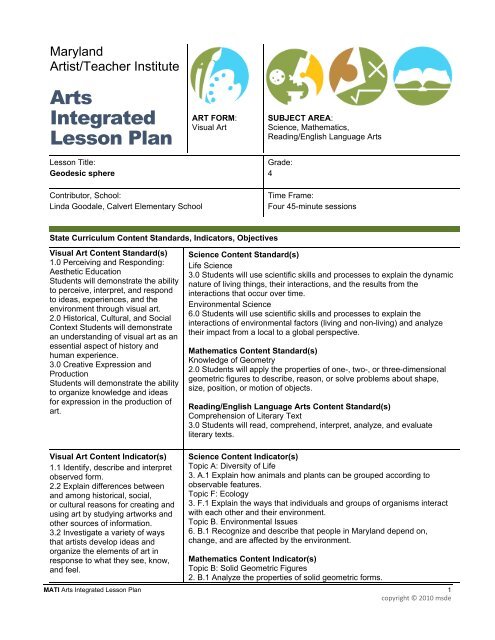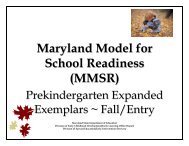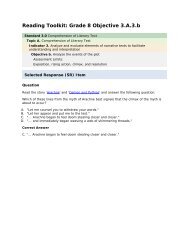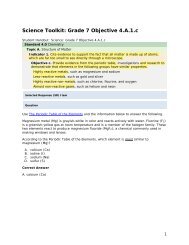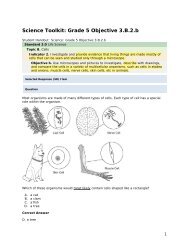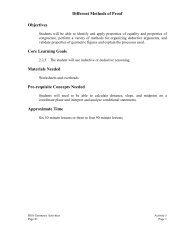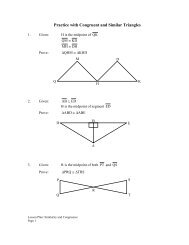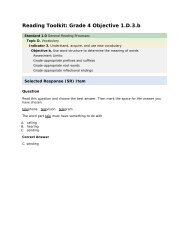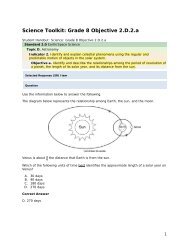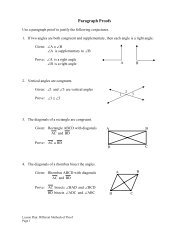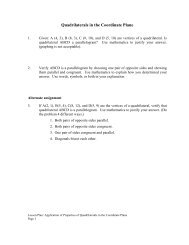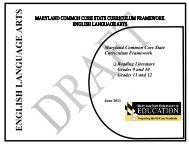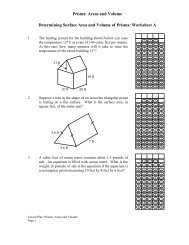Arts Integrated Lesson Plan - mdk12
Arts Integrated Lesson Plan - mdk12
Arts Integrated Lesson Plan - mdk12
Create successful ePaper yourself
Turn your PDF publications into a flip-book with our unique Google optimized e-Paper software.
Maryland<br />
Artist/Teacher Institute<br />
<strong>Arts</strong><br />
<strong>Integrated</strong><br />
<strong>Lesson</strong> <strong>Plan</strong><br />
<strong>Lesson</strong> Title:<br />
Geodesic sphere<br />
ART FORM:<br />
Visual Art<br />
SUBJECT AREA:<br />
Science, Mathematics,<br />
Reading/English Language <strong>Arts</strong><br />
Grade:<br />
4<br />
Contributor, School:<br />
Linda Goodale, Calvert Elementary School<br />
Time Frame:<br />
Four 45-minute sessions<br />
State Curriculum Content Standards, Indicators, Objectives<br />
Visual Art Content Standard(s)<br />
1.0 Perceiving and Responding:<br />
Aesthetic Education<br />
Students will demonstrate the ability<br />
to perceive, interpret, and respond<br />
to ideas, experiences, and the<br />
environment through visual art.<br />
2.0 Historical, Cultural, and Social<br />
Context Students will demonstrate<br />
an understanding of visual art as an<br />
essential aspect of history and<br />
human experience.<br />
3.0 Creative Expression and<br />
Production<br />
Students will demonstrate the ability<br />
to organize knowledge and ideas<br />
for expression in the production of<br />
art.<br />
Science Content Standard(s)<br />
Life Science<br />
3.0 Students will use scientific skills and processes to explain the dynamic<br />
nature of living things, their interactions, and the results from the<br />
interactions that occur over time.<br />
Environmental Science<br />
6.0 Students will use scientific skills and processes to explain the<br />
interactions of environmental factors (living and non-living) and analyze<br />
their impact from a local to a global perspective.<br />
Mathematics Content Standard(s)<br />
Knowledge of Geometry<br />
2.0 Students will apply the properties of one-, two-, or three-dimensional<br />
geometric figures to describe, reason, or solve problems about shape,<br />
size, position, or motion of objects.<br />
Reading/English Language <strong>Arts</strong> Content Standard(s)<br />
Comprehension of Literary Text<br />
3.0 Students will read, comprehend, interpret, analyze, and evaluate<br />
literary texts.<br />
Visual Art Content Indicator(s)<br />
1.1 Identify, describe and interpret<br />
observed form.<br />
2.2 Explain differences between<br />
and among historical, social,<br />
or cultural reasons for creating and<br />
using art by studying artworks and<br />
other sources of information.<br />
3.2 Investigate a variety of ways<br />
that artists develop ideas and<br />
organize the elements of art in<br />
response to what they see, know,<br />
and feel.<br />
Science Content Indicator(s)<br />
Topic A: Diversity of Life<br />
3. A.1 Explain how animals and plants can be grouped according to<br />
observable features.<br />
Topic F: Ecology<br />
3. F.1 Explain the ways that individuals and groups of organisms interact<br />
with each other and their environment.<br />
Topic B. Environmental Issues<br />
6. B.1 Recognize and describe that people in Maryland depend on,<br />
change, and are affected by the environment.<br />
Mathematics Content Indicator(s)<br />
Topic B: Solid Geometric Figures<br />
2. B.1 Analyze the properties of solid geometric forms.<br />
MATI <strong>Arts</strong> <strong>Integrated</strong> <strong>Lesson</strong> <strong>Plan</strong> 1<br />
copyright © 2010 msde
2. B.2 Analyze the relationship between plane geometric figures and<br />
surfaces of solid geometric figures.<br />
Reading/English Language <strong>Arts</strong> Content Indicator(s)<br />
3.1 Develop comprehension skills by reading a variety of self-selected and<br />
assigned literary texts, including print and non-print texts.<br />
3.2 Use text features to facilitate understanding of literary texts.<br />
Fine <strong>Arts</strong> Content Objective(s)<br />
1.b Represent relationships among<br />
observed people, animals, and<br />
objects in a composition by<br />
selecting and using the elements of<br />
art to achieve specific effects.<br />
2.a<br />
Identify technologies, processes,<br />
and materials used<br />
to create visual art.<br />
2.b Describe the origins of selected<br />
technologies, processes, and<br />
materials used in the visual arts.<br />
3..a Describe sources for ideas and<br />
compare the processes used to<br />
create artworks based on those<br />
sources.<br />
Science Content Objective(s)<br />
3.A.1.a Observe and compile a list of a variety of animals or plants in both<br />
familiar and unfamiliar environments<br />
3.F.1.a Identify and describe the interactions of organisms present in a<br />
habitat.<br />
• Competition for space, food, and water<br />
• Beneficial interactions: nesting, pollination, seed dispersal,<br />
oysters filtering, as in the Chesapeake Bay, etc.<br />
• Roles within food chains and webs: scavengers, decomposers,<br />
producers, consumers<br />
6.B.1.a Identify and describe that human activities in a community or<br />
region are affected by environmental factors.<br />
• Presence and quality of water<br />
• Soil type<br />
• Temperature<br />
• Precipitation<br />
Mathematics Objectives<br />
2.B.1.b Describe solid geometric figures by the number of edges, faces, or<br />
vertices.<br />
2.B.2.b Compare a plane figure to surfaces of solid geometric<br />
figure<br />
Reading/English Language <strong>Arts</strong> Content Objective(s)<br />
3.1. b Listen to critically read and discuss a variety of literary forms and<br />
genres.<br />
Objective a. Identify how organizational aids such as the title of the book,<br />
story, poem, or play contribute to meaning.<br />
3.2 b Identify how graphic aids such as pictures and illustrations,<br />
punctuation, and print features contribute to meaning.<br />
3.2.c Identify and explain how informational aids such as introductions and<br />
overviews, materials lists, timelines, captions, glossed words, labels,<br />
numbered steps, bulleted lists, footnoted words, pronunciation keys,<br />
transition words, end notes, works cited, and other informational aids<br />
encountered in informational texts contribute to meaning.<br />
Objective(s) (Connecting the content areas)<br />
Students will use research strategies to create an illustration to express scientific concepts related to an animal<br />
or plant and its environment. Students will use sculptural techniques to create geometric three-dimensional forms<br />
to illustrate the food chain.<br />
MATI <strong>Arts</strong> <strong>Integrated</strong> <strong>Lesson</strong> <strong>Plan</strong> 2<br />
copyright © 2010 msde
Key Art Vocabulary<br />
illustration, three-dimensional<br />
Key Science Vocabulary<br />
• biodiversity—the range of organisms present in a given ecological<br />
community or system<br />
• biome—a division of the world’s vegetation that corresponds to a<br />
particular climate and is characterized by certain types of plants<br />
and animals, e.g., tropical rain forest or desert<br />
• ecology—the study of the relationships and interactions between<br />
living organisms and their natural or developed environment<br />
• environment—relating to the natural world, especially to its<br />
conservation, or an animal’s surroundings<br />
• food chain—a hierarchy of different living things, each of which<br />
feeds on the one below it<br />
Key Mathematics Vocabulary<br />
• geodesic—the shortest line between two points on a<br />
mathematically defined surface<br />
Prior Knowledge Students Need for This <strong>Lesson</strong><br />
Art<br />
• Students need familiarity<br />
with drawing natural objects<br />
from observation.<br />
• Students should<br />
understand basic<br />
composition elements to<br />
apply to their drawings.<br />
Reading/ Language <strong>Arts</strong><br />
• Students need to know how to get information from a variety of<br />
sources: books, diagrams, illustrations, and web sites<br />
Materials and Resources<br />
Materials and Resources for the<br />
Class<br />
• Just a Dream by Chris Van<br />
Allsburg<br />
• 30 sheets of recycled<br />
drawing or construction<br />
paper<br />
• 30 large cardboard tubes<br />
(recycled from laminator<br />
film)<br />
• Fine black and/or colored<br />
markers<br />
• Heavy yarn or twine or<br />
fishing line<br />
• Toothpicks and dried peas<br />
• Teacher-created<br />
worksheets based on<br />
research information<br />
Materials and Resources for the Teacher<br />
Linnaeus devised a system for classifying plants and animals under two<br />
names, one referring to the genus and one to the species.<br />
Nonfiction<br />
Smith, A.G. (1986). 3-D Geometrical Shapes. New York: Dover<br />
Publications.<br />
Pollock, S. (1993). Ecology. London: Doeling Kindersley.<br />
Fullick, A. (2000). Ecosystems & Environment., Des Plaines, Illinois:<br />
Heinemann Library.<br />
Fiction<br />
Van Allsburg, Chris. (1990). Just a Dream. New York: Scholastic.<br />
Web sites<br />
www.epa.gov<br />
www.4cleanair.org<br />
Animal cards<br />
<strong>Lesson</strong> Development/Procedures (including motivation, modeling, guided practice, and independent<br />
practice)<br />
• Read the story Just a Dream by Chris Van Allsburg and discuss it with the class. What additional<br />
information is found in the illustrations which are not in the text? Why didn’t the artist use captions? In<br />
MATI <strong>Arts</strong> <strong>Integrated</strong> <strong>Lesson</strong> <strong>Plan</strong> 3<br />
copyright © 2010 msde
some of Van Allsburg’s books (e.g., Two Bad Ants), he likes to use an unusual point of view. Is there a<br />
particular point of view in Just a Dream? Why, or why not? Compare this point of view to that in We<br />
Will Miss Them by Alexandra Wright. Do the books have a similar theme? How are the themes<br />
different?<br />
• Have the class brainstorm and make a list of thirty (or more) different species of plants and animals.<br />
• Allow each student to select a card (one of thirty, made by the teacher from the list, each containing<br />
the name of a different type of living species). Students may trade with one another if they wish, but<br />
each student must do a different task.<br />
• Give each student a sheet of white drawing paper and explain that they are to create a composition in<br />
pencil, made up of drawings of examples of their types of plants or animals. They are allowed to use<br />
reference materials to draw from (the teacher will have a variety of books, encyclopedias, magazines,<br />
photographs, leaves, shells, pinecones, etc. , available, or Web sites may be consulted). Each student<br />
is asked to write a brief description of the species and its environmental needs and identify other<br />
species that it may interact with. (Use worksheets made in advance by the teacher.)<br />
• After students have completed compositions in pencil on the drawing paper, they may use markers to<br />
outline their drawings. Finished drawings may be photocopied for display.<br />
• Each student is then given a cardboard tube and asked to glue his/her drawings around it, using<br />
rubber bands to hold the drawings in place until the glue is dry. The drawing paper should be pre-cut<br />
to fit the tube exactly.<br />
• Ask the students: “What is the strongest shape?” Hand out a number of polygons made from tag<br />
board strips with paper fasteners at the corners (made in advance by the teacher). Allow the students<br />
to manipulate the different shapes—square, triangle, hexagon, pentagon, octagon, decagon, etc.<br />
(Eventually, they will realize that the more sides a plane figure has, the weaker it is and that, therefore,<br />
the triangle is the strongest geometric shape. This is why triangular figures are seen so often in<br />
bridges and as reinforcements in all types of structures).<br />
• Provide examples of geometric solid shapes. Have the students identify the plane shapes of the sides<br />
and guess the number of sides of each solid. Distribute the toothpicks and the dried peas (which have<br />
been soaked overnight) to all the students and have them create geometric solid forms by using the<br />
peas to hold the toothpicks together at the corners. When the peas dry, the students can take them<br />
home. Then have the students draw how the geometric form would look flattened on a piece of paper.<br />
Make sure that all sides are shown. Show pictures of the work of R. Buckminster Fuller, especially his<br />
geodesic domes. Discuss his ideas.<br />
• Have the students lay out the completed tubes on the tables and try to form connections between the<br />
species, as in a food chain or web of interdependence. For example, join the bear tube to the salmontype<br />
fish tube. Try to lay out all the tubes into the shape of a flattened dodecahedron. Use heavy yarn<br />
threaded through the decorated cardboard tubes to tie them together to form triangles. Then tie all the<br />
triangles together to make a geodesic sphere. When joining the decorated tubes, have the students try<br />
to make connections between the species. Hang the finished products from the ceiling.<br />
• Using tissue paper or cellophane, have the students cut out the shapes of the continents in the<br />
geodetic manner described by Fuller and attach them to the biodiversity sphere so that the underlying<br />
drawings will show through.<br />
________________________________________________________________________________________<br />
Closure/Summary<br />
Students share work with the class and discuss why they connected their pieces in relationship to the food<br />
chain.<br />
Assessment (Description/Tools)<br />
Fine <strong>Arts</strong> Assessment (Description/Tools)<br />
The students’ drawings will be assessed for:<br />
• Use of several sources for research on the selected species.<br />
• Accuracy in drawing the subjects.<br />
• Drawing several variations (or poses) of the species.<br />
• Arranging the images in an interesting composition.<br />
Reading/Language <strong>Arts</strong> Assessment (Description/Tools)<br />
Students will be assessed on their understanding of the story by their responses and discussion.<br />
MATI <strong>Arts</strong> <strong>Integrated</strong> <strong>Lesson</strong> <strong>Plan</strong> 4<br />
copyright © 2010 msde
Mathematics Assessment (Description/Tools)<br />
Students’ geometric solid models and their explanatory drawings will be used to assess their understanding of<br />
geometric forms.<br />
Science Assessment (Description/Tools)<br />
Worksheets will be assessed for accuracy and completeness.<br />
<strong>Lesson</strong> Extensions<br />
None<br />
MATI <strong>Arts</strong> <strong>Integrated</strong> <strong>Lesson</strong> <strong>Plan</strong> 5<br />
copyright © 2010 msde


